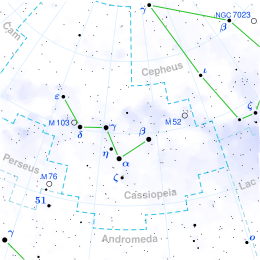Top Qs
Timeline
Chat
Perspective
8 Andromedae
Multiple star system in the constellation Andromeda From Wikipedia, the free encyclopedia
Remove ads
8 Andromedae, abbreviated 8 And, is a probable triple star[12] system in the northern constellation of Andromeda. 8 Andromedae is the Flamsteed designation. It is visible to the naked eye with an apparent visual magnitude of 4.82.[2] Based upon an annual parallax shift of 5.7 mas, it is located about 570 light years from the Earth. It is moving closer with a heliocentric radial velocity of −8 km/s.[6]

The primary component is an ageing red giant star with a stellar classification of M2.5 III Ba0.5.[4] The suffix notation indicates this is a mild barium star, which means the stellar atmosphere is enriched with s-process elements. It is either a member of a close binary system and has previously acquired these elements from a (now) white dwarf companion or else it is on the asymptotic giant branch and is generating the elements itself.[13] This is a periodic variable of unknown type, changing in brightness with an amplitude of 0.0161 magnitude at a frequency of 0.23354 d−1, or once every 4.3 days.[14]
The third component is the magnitude 13.0 star at an angular separation of 7.8″ along a position angle of 164°, as of 2015.[15] It has a Gaia Data Release 3 parallax of 5.7 mas and a proper motion almost identical to 8 Andromedae.[16] A number of other faint stars within a few arc-minutes of 8 Andromedae have been listed as companions, but none are at the same distance.[17]
Within Andromeda it is the second of a northerly chain asterism – 11 is further south-westward, with 7, 5, then 3 Andromedae in the other direction.
Remove ads
References
Wikiwand - on
Seamless Wikipedia browsing. On steroids.
Remove ads

